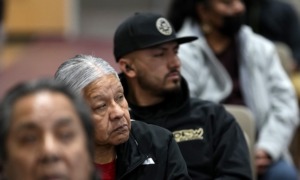Six in 10 African-American youth believe “it is hard for young black people to get ahead because they face so much discrimination,” according to a University of Chicago (UC) report released in February.
“The Black Youth Project: The Attitudes and Behavior of Young Black Americans,” reports the findings of phone interviews with almost 1,600 fifteen- to 25-year-olds. UC professor Cathy J. Cohen headed an impressive team of 59 predominantly black and Hispanic graduate student researchers, who in many ways were peers of the youths they interviewed.
It’s not surprising that most black youths agree with the assessment quoted above, given the high rates of unemployment and incarceration among young African-Americans. What is surprising is the finding that 45 percent of Hispanic youth and 43 percent of white youth agree that young blacks are discriminated against. This stands out because it asks black, white and Hispanic youth to offer their views about the black youth experience.
Here are some more findings, with the percentages among black, Hispanic and white youth listed in that order:
• 79, 73 and 63 percent believe police discriminate much more against black youth than against white youth.
• 54, 40 and 31 percent believe that black youth receive a poorer education, on average, than do white youth.
• 59, 52 and 32 percent believe the health care system treats blacks less fairly than whites.
• 68, 50 and 34 percent believe the government would do more to find a cure for AIDS if more white people had the disease.
The percentages of blacks perceiving discrimination against blacks are consistently higher than those of Hispanics and whites. The researchers conclude that these differences are not evidence of paranoia or system-blaming, but reflect the fact that black youth live in two worlds: “one that proclaims to be a color-blind society and the other still rooted in racism and a racial hierarchy.”
The closer Hispanic and white youth come to experiencing or seeing the darker world of racism – such as what Hispanics experience in health care and when whites see police mistreatment – the more likely they are to share the views of black youth.
There is a bright side to the study. It reconfirms the findings that young people of all backgrounds believe they can make a difference, even in a country that doesn’t see youth as a priority group.
Here again are some findings among blacks, Hispanics and whites:
• 79, 77 and 79 percent believe that they can personally make a difference by participating in politics.
• 74, 66 and 70 percent believe they have the skills and the knowledge to do so.
• 25, 20 and 23 percent demonstrate their views by participating in “buycotts” (buying a product or service because of the company’s social or political views).
• 56, 52 and 44 percent believe that leaders in government “care very little about people like them.”
For youth-serving organizations, just as for schools, achieving racial diversity is a more common goal than acknowledging racial prejudices and misconceptions, exploring racial differences or helping youth develop personal and collective strategies to confront structural racism.
In 2003, the Philanthropic Initiative for Racial Equity kicked off the Youth and Racial Equity Project, funded by the Ford and Charles Stewart Mott foundations. Daniel HoSang, Julie Quiroz-Martinez and Lori Villarosa did literature reviews, convened researchers, funders and practitioners, and visited organizations such as the Urban Underground in Milwaukee and Asian/Pacific Islander Youth Promoting Advocacy and Leadership, in Oakland.
Their 2004 report, “Changing the Rules of the Game,” identified five common strategies:
1. Confront racism directly. Teach history, build awareness and provide opportunities for discussion.
2. Engage youth in analyzing structural racism. Help them connect personal experiences with root causes.
3. Offer opportunities for group action. Help youth identify systemic solutions and develop political and community actions.
4. Create processes for racial identity development and healing. Support self-reflection, cultural exploration and personal decision-making assessment.
5. Build common racial justice analyses among staff and volunteers. Make sure these steps are done first with the staff.
According to the UC study, 42 percent of black and Hispanic youth and 33 percent of white youth believe racism will not be eliminated during their lifetimes. That’s another 60 years of business as usual unless we change the way we do business.
Download the university study (www.blackyouthproject.com) and the PRE report (www.racialequity.org). Share the results with staff and youth. Help them name and give voice to the darker external realities that oppress us all.































